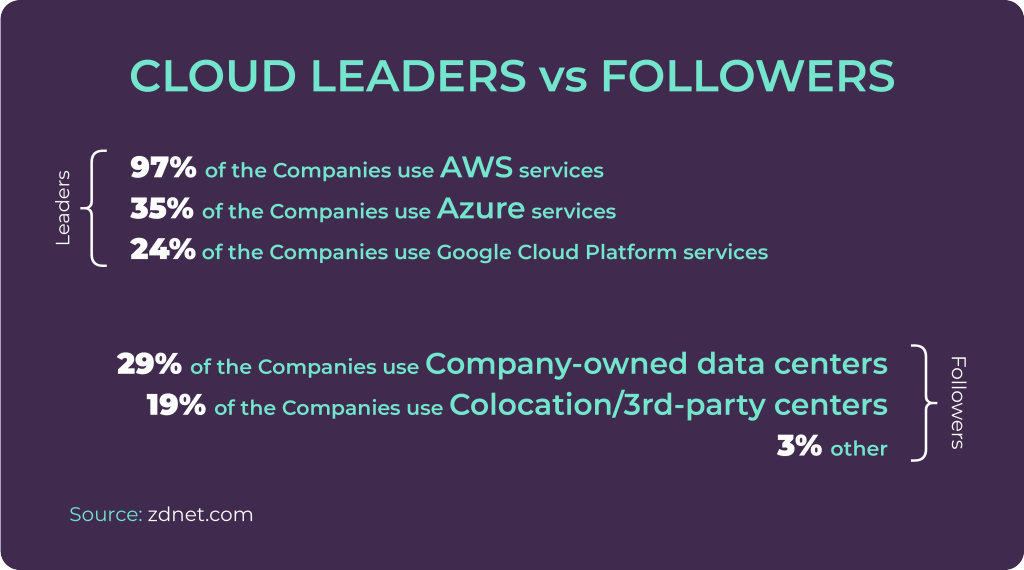IT industry never ceases to evolve. From clouds, to VMs, to containers… We never know what its next move will be like, but are instinctively ready to adopt to its beneficial transformations. Or not? In this article, we’re talking about cloud automation to introduce the newbies to its perks and remind the old-schoolers of what they’re losing by giving it a cold shoulder.
written by:
Veronica Chizh
IT industry never ceases to evolve. From clouds, to VMs, to containers… We never know what its next move will be like, but are instinctively ready to adopt to its beneficial transformations. Or not? In this article, we’re talking about cloud automation to introduce the newbies to its perks and remind the old-schoolers of what they’re losing by giving it a cold shoulder.
According to Hosting Tribunal, in 2019 the global public cloud computing market is likely to reach $258 billion in value. The figures are quite promising, however in reality IT community is growing unevenly.
The IT world is still separated into two camps, which are the leaders and the followers. The leaders are pushing the statistics up and are responsible for the overall good reputation that the industry creates. On the other hand, the followers are pretty satisfied with legacy tools and methods, which, despite the fact that they’re still quite widespread and adequate for a certain set of tasks, have a negative impact on the whole industry evolution. See the chart below for the contribution of the cloud leaders vs the followers' contribution to the cloud industry adoption.
In our article, we’re going to discuss why it is urgent to ensure the consistent growth of the entire IT industry and how to achieve it through cloud automation tools and methods.
Shift from legacy to cloud-native applications
Many IT companies selling top-notch products are still using legacy on-prem systems and don’t want to go cloud. Partly, their choice is justified due to numerous operational factors. First, the equipment cost - which can give a budget a hard blow - often takes more than 10+ years to write-off. Second, certain business processes may have been tailored to fit critical business objectives and are too risky and labor-intensive to retire. Migration is all too often delayed due to the operational risk of some updates because during migration data may be lost or corrupted. Apart from the business-related issues, total on-prem facilities overtuning often implies dealing with human factor, as human beings tend to resist the new.
If the old solution works, why change it? After that, despite staying afloat quite for some time, eventually the followers face compatibility failures, security breaches as ultimate security solutions are unavailable to them. Surely, performance suffers most, as in time, legacy solutions require more resources to run and are way slower than their up-to-date substitutes. This in the end slows down the overall growth of the industry, as the followers are innovation blockers. They stick to the old-school tools and methods of work even when it’s economically unfeasible.
Just like in case with legacy systems, conventional methods like manual application testing, manual configuration and release management are not intrinsically bad. They’re just not as efficient as they might be. Together, cloud initiatives (as an alternative to legacy on-prem applications) and automation (which facilitates app development, testing and release) form a new-age attitude towards efficient app development.
What is cloud automation and why is it so important?
Cloud automation mainly implies activities to ensure automated infrastructure provisioning and application management in the cloud.
Ensuring automatic infrastructure provisioning in the DevOps era is crucial, as to efficiently test and release new applications the organization needs adequate environments for this. Environment provisioning is not a one-time process, as it is done before the project team kicks off, during actual application development or testing and after the application release. Thus, the provisioning automation hits a set of objectives that make the life of the entire project team easier.
First, the automated provisioning for physical and virtual machines, processing power, storage, databases, middleware, communication and networking infrastructure is done faster, which reduces average time to provision. Second, adequate centralized automated provisioning facilitates decision-making processes in case new/urgent business issues arise. Scalability, impact analysis and changes management are no longer pain points and the company is 100% ready to face new challenges. Along with that, provisioning automation provides useful insights on service allocation and helps reduce operational waste and complexity through following well-run operational patterns and templates.
All in all, provisioning automation facilitates onboarding for new application teams, coordination of code releases and infrastructure management, procuring and environment generation for Devs and QA and self-service provisioning, offering a set of services that can be automatically launched and managed.
As for the application management in the cloud, application management tools ensure traceability and transparency of the cloud resources. Top-notch metrics and visualization tools allow businesses to effectively monitor cloud infrastructure and receive reliable updates on tier availability, performance, and throughput. Organizations visualize their application dependencies to monitor communication and architecture issues, see what’s located and where. Cloud management tools also facilitate migrating on-prem resources into the cloud and ensure their better allocation. Businesses can see clearly their capacities consumption to use only what they need and scale up on the go.
See IBM Cloud App Management as an example. It offers its clients application management features which greatly exceed even those mentioned above. With IBM’s continuous delivery support, businesses can provide their dev teams and SREs with high-end analytics to fight the errors and bugs. The insights that the IBM cloud app management provides will help companies communicate with IT Ops and DevOps teams to identify operational bottlenecks. The cloud giant also facilitates workload provisioning, configuration and deployment on VMs/containers for its clients. Monitoring resources across cloud and on-prem facilities is now available from a single control point. For those keen on Cloud-native infrastructure, IBM avails support of dynamic workloads, Kubernetes environments management along with application performance management in hybrid and multicloud environments. Open-source data collectors allow automating microservice-based application management. Get valuable insights on the systems health through central monitoring and cognitive analytics and much more.
How to ensure cloud automation?
Which tools will help in achieving ambitious cloud automation objective?
We recommend using the following tools and platforms to automate application release, infrastructure provisioning and ensure first-class orchestration for your cloud computing projects.
Application release automation:
UrbanCode Deploy by IBM, MicroFocus Deployment Automation, XebiaLabs XL Deploy, GoCD by ThoughtWorks
Cloud Management platforms:
Apache CloudStack, Cloudcraft, CloudBolt, VMware vRealize
Orchestration tools:
Google Cloud Deployment Manager, Microsoft Azure Automation, Cisco Intelligent Automation for Cloud, SaltStack
Configuration tools:
Ansible, Chef, Puppet, Terraform, Salt.
Conclusion
Sure thing, legacy tools can be adopted to the modern-day requirements, while the value of manual human labor won’t diminish dramatically in the IT sector in the coming years. However, the gradual shift from slow to prompt development along with manual to automated operations has already become a reality for the industry. The leaders are those who have adopted their corporate culture to meet these demands. On-prem to cloud, legacy to new and manual to automation transformation will take time to hit the whole IT market. It may bring havoc into well-run old-school processes, may force the sluggish players out of the game, but eventually it will result into a more customer-oriented, agile and responsive arena for us, the consumers.
Qulix Systems has extensive expertise in cloud services. We’re ready to render any assistance you may need to apply every best feature that cloud computing market affords today. For more information contact our Support team or visit our website.

Contacts
Feel free to get in touch with us! Use this contact form for an ASAP response.
Call us at +44 151 528 8015
E-mail us at request@qulix.com







